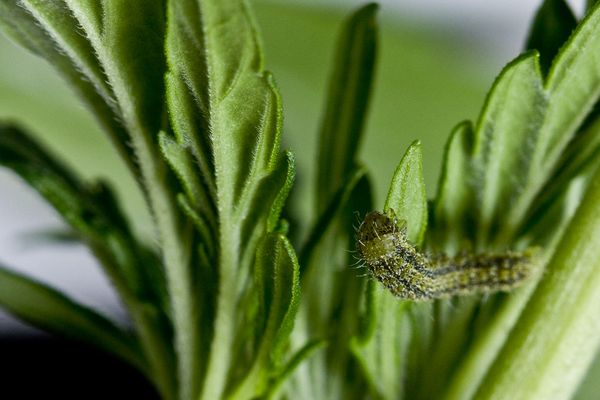- One of the biggest fears for growers is having a caterpillar infestation strike their marijuana plants. These ravenous insects are very common when growing marijuana outside and less frequently found inside.
- So, if you have decided to start or continue growing cannabis this season, you should be very careful because these little visitors can ruin your crop and leave you without any supplies for winter.
- Here we explain everything you need to know about caterpillar infestations – how to identify them, prevent them and get rid of them. Let’s get started.

How can you tell whether your cannabis plants are infested with caterpillars?
Caterpillars are a kind of insect larvae which belongs to the lepidoptera family. They have a cylindrical body which is divided into segments, six legs, plus another five pairs of false legs. These chewing creatures are one of the crop diseases which are most feared by cannabis growers. Caterpillars are commonly known for their metamorphosis stage where they transform into bright, beautiful butterflies. Their life cycle is simple: butterflies lay eggs on the plant and, when these hatch, caterpillars emerge. They eat non-stop until they reach the right size and have the ideal conditions to create a chrysalis before turning into a butterfly while inside. During the first stage, when they are still caterpillars, they can vary a lot in terms of appearance, ranging from green to a whole host of colours. However, the ones that attack cannabis plants are usually green.
These insects devour plant matter very quickly, so you must pay close attention if you don't want these undesirable diners to feast on your plants. Here are the symptoms that you should look out for:
- Spray your plants with pyrethrum and keep an eye on them: This quick-acting spray stuns caterpillars and they fall off the plant immediately. Another trick for finding them is to inspect your marijuana plant at night. They are more difficult to spot during the day but if you use a torch at night, you'll find it easier to see them. They are also more active at night, so they will be more visible.
- Look out for butterflies: If you see any butterflies resting on your plants, try to chase them away because they could be laying eggs. If you have seen butterflies on your plants, you should start to be suspicious and check for caterpillars.
- Inspect your plant: Keep an eye out for small yellow or translucent eggs on the underside of the leaves, as this tends to be where butterflies lay them. You should also check for any little droppings that caterpillars leave as they move around. These small black deposits are a sign that they are present.
- Bitemarks on the leaves: As we mentioned earlier, this insect feeds on green matter so if you find any bitemarks on your plants (especially on the leaves), it's highly likely that your crop is being attacked by caterpillars. Infestations like this can cause severe damage to the foliage of the plant and slow down its growth and metabolic functions. In very extreme cases, the plant can even die.
- Dark stains or rot on the buds: Caterpillars can also get inside the buds. Inspect them and check for any bitemarks or signs of caterpillars. It's essential to act fast if you notice any of these symptoms. Apart from the fact that these insects have an insatiable hunger and are able to quickly demolish the biggest marijuana buds in your crop, the droppings they leave behind can also encourage the appearance of fungus (usually botrytis).
How can you get rid of a caterpillar infestation?
If the caterpillar has already made itself at home in your marijuana crop, it's vital that you act as quickly as possible. Take note because here are some biological remedies that you can use:
- Manual removal: Armed with patience and plastic gloves, you can remove any caterpillars that you find on your plants.
- Spraying: You can combine manual removal with homemade insecticides, such as a blend of pepper and garlic.Pyrethrum and rotenone also work very well. Use
- Bacillus thuringiensis: We recommend this biological insecticide as the most effective method for treating caterpillar infestations. This insecticide acts upon contact, which means that caterpillars fall ill and die when they are sprayed with Bacillus. You should remember that even though it is a biological product, it is advisable to play it safe and refrain from applying it during the last 15 days of the cycle. It is also a good idea to combine sprays of this product with manual removal.
- Introduce predator species: Trichogramma wasps and Podisus maculiventris can be quite helpful. And if the infestation of caterpillars appears at harvest time…
What if caterpillars appear at the moment of the harvest?
Regardless of how many measures you have taken against caterpillar infestations, some of them might have escaped the purge and remain hidden on your plants. When harvesting, it is important to hang the plants upside down and look very carefully. If there are any caterpillars left on your crop, these unwanted lodgers will pack their bags and leave in search of greener pastures when the plants start to dry up because they will no longer be able to live off them. You should pay close attention because if they do manage to escape without being seen, they can complete their life cycle by creating chrysalises in the most unexpected corners of your house. This means that the cycle begins again and it turns into a never-ending story.



Comments from our readers
There are no comments yet. Would you like to be the first?
Leave a comment!Did you like this post?
Your opinion about our seeds is very important to us and can help other users a lot (your email address won't be made public).